
Caltech professor Kerry Vahala’s lab has developed a silicon-based laser gyroscope that can measure the rotation of the earth.
Gyroscopes have been indispensable tools for navigation and measurement for many decades.
Early gyroscopes were not much different than spinning tops, but the technology has advanced so much over the years that the modern gyroscope no longer resembles a child’s toy. Today, there are two kinds in widespread use: optical gyroscopes, which are extremely sensitive but also expensive, and microelectromechanical system (MEMS) gyroscopes, which are inexpensive and easy to manufacture, but much less sensitive to rotation.
Optical gyroscopes are used in applications such as aircraft navigation systems, while MEMS gyroscopes are found in devices like smartphones. For the last few decades, researchers have wondered whether it would be possible to bridge the gap between these two technologies and create a new type of gyroscope that combines the precision of laser gyroscopes with the ease of manufacture of MEMS gyroscopes. Now, Caltech scientists have developed an optical gyroscope that marries some of the best characteristics of each into one device.
In a new paper published in Nature Photonics, Kerry Vahala (BS ’80, MS ’81, Ph.D. ’85), Caltech’s Ted and Ginger Jenkins Professor of Information Science and Technology and Applied Physics, describes a laser gyroscope his lab built from a piece of silicon-based material in much the same way that MEMS devices are manufactured. The new type of gyroscope has achieved something considered a benchmark for gyroscopes: the ability to measure the rotation of the earth.
“For more than 20 years, researchers have speculated about placing optical gyroscopes onto a chip very much like the highly successful MEMS gyroscopes. But until recently, there have been very few compelling experiments,” Vahala says.
That started to change about a decade ago because of dramatic progress in improving the performance of silicon-chip-based optical resonators and waveguides. Those developments are now starting to pay off.
All optical gyroscopes, including the one developed by Vahala, make use of something known as the Sagnac effect to measure rotation. Two light waves traveling in opposite directions around a ring-like path will have equal propagation times. However, when the path rotates, the time to reach a specific point on the rotating path will be different for each wave. This difference provides a measure of the rate of rotation and can be determined very precisely by measuring the interference between the two light waves.
There are two versions of optical gyroscope. In a laser gyroscope, the ring-shaped path consists of a series of discrete mirrors off of which the light bounces. Fiber optical gyroscopes, on the other hand, use a spool of fiber optic cable that can be hundreds or even thousands of meters long.
In Vahala’s gyroscope, the pathway is a circular silica disk, and the laser light is generated by high frequency vibrations in the disk through a process called stimulated Brillouin scattering.
Although the shorter light path in Vahala’s gyroscope helps to keep the device smaller, it could also result in lower sensitivity. To make up for that, the light is “recycled,” says Yu-Hung Lai, co-author on the paper. “The light is allowed to circulate around the path again and again, creating a stronger Sagnac effect and greater sensitivity to rotation.”
“Also, the Brillouin laser action magnifies this sensitivity even further by compensating for the optical loss in the disk,” notes Myoung-Gyun Suh, who is also a co-author on the paper.
In addition to such a gyroscope’s potential for improved sensitivity relative to MEMS gyroscopes, such a system would have no moving parts and could be very resilient to vibrations and shocks. That resiliency is, in fact, one of the key reasons for interest in chip-scale optical gyroscopes, as their ultimate physical size will likely be larger than MEMS devices.
Vahala says that the ability to measure the earth’s rotation is an interesting benchmark for chip-scale gyroscopes. It is also a rate that is quite low, which makes it a challenge to measure. To illustrate how low it is, he imagines an ice skater spinning on one skate, but making one full turn once a day.
Vahala says his lab will continue studying these devices, and that preliminary experimental evidence suggests they can be made considerably more sensitive.
“We’d like to improve performance by a factor of 10- to 100,” he says. “At that point, these devices would exceed the performance of the majority of MEMS gyroscopes. In theory, this is possible because traditional optical gyroscopes offer performance that is many orders better than MEMS devices.”
The paper describing the research, titled, “Earth rotation measured by a chip-scale ring laser gyroscope,” appeared in the February 17 issue of Nature Photonics. Co-authors include graduate students Boqiang Shen (MS ’18) and Heming Wang; postdoctoral scholar Qi-Fan Yang (MS ’16, Ph.D. ’19); and Yu-Hung Lai (MS ’16, Ph.D. ’19), Myoung-Gyun Suh (MS ’14, Ph.D. ’17), Yu-Kun Lu, Jiang Li (MS ’12, Ph.D. ’13), Seung Hoon Lee, and Ki Youl Yang (MS ’12, Ph.D. ’18), all formerly of Caltech.
Reference: “Earth rotation measured by a chip-scale ring laser gyroscope” by Yu-Hung Lai, Myoung-Gyun Suh, Yu-Kun Lu, Boqiang Shen, Qi-Fan Yang, Heming Wang, Jiang Li, Seung Hoon Lee, Ki Youl Yang and Kerry Vahala, 17 February 2020, Nature Photonics.
DOI: 10.1038/s41566-020-0588-y
CaltechAUTHORS: 20200101-104456130
Funding for the research was provided by the Defense Advanced Research Projects Agency (DARPA).

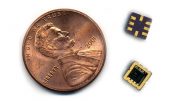
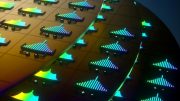
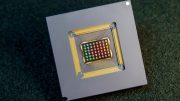
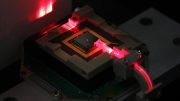
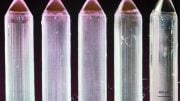
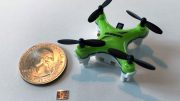
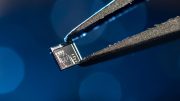

Are the lasers accurate enough to measure the fact that your animation has the earth spinning backward?